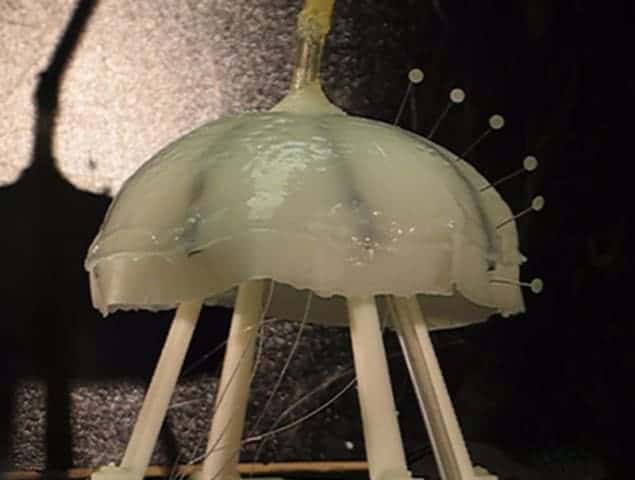
A robotic swimmer that mimics the motion of a jellyfish has been built by researchers in the US. Dubbed “Robojelly”, the swimmer propels itself using an “artificial muscle” built in part from carbon nanotubes and powered by hydrogen. Such robots could be used in a number of scientific, military and commercial marine applications, the researchers say.
Robojelly has been built by a team led by Yonas Tadesse from Virginia Tech and the University of Texas at Dallas that is claiming “the first successful powering of an underwater robot using external hydrogen as a fuel source”. As well as only producing water as a waste product, hydrogen is attractive for remote marine vehicles because, in principle, the fuel could be obtained from seawater using energy from the Sun.
Deform and reform
At Robojelly’s heart is a commercially available nickel-titanium shape-memory alloy (SMA) – a deformable material that returns to its original shape when heated. The SMA is wrapped in a sheet of carbon nanotubes that itself is coated in titanium particles, which catalyse the reaction between hydrogen and oxygen. The heat produced as a result of this oxidation then allows the SMA to revert to its original shape.
Robojelly uses carbon nanotubes because they are highly porous, which allows the hydrogen and oxygen to reach the catalyst. And apart from being lightweight and very robust, nanotubes also conduct heat well, which is good because heat must be transferred quickly to and from the SMA during operation.
The robot has an umbrella-like structure that mimics the propulsion strategy of the common jellyfish Aurelia aurita. The “bell” of the robot is made from silicone and is supported by eight springy steel ribs, with a string running alongside each rib from the edge of the bell to a pulley at the centre. Each string then goes down into a tube that holds the SMA actuator.
In one design, all the strings are attached to one central SMA actuator, while in another design there are eight different actuators. One benefit of the latter design is that, in principle, different segments of the bell can be controlled individually. “This should allow the robot to be controlled and moved in different directions,” explains Tadesse.
Flapping bell
To demonstrate Robojelly in action, the team placed it in a tank of water. A fixed amount of hydrogen and oxygen is then introduced to the tube, which warms up the SMA and makes it change shape. As it deforms, the alloy pulls on the strings, causing the bell to flap in one direction. As the SMA cools, the restoring force of the steel ribs makes the bell flap in the opposite direction. According to the team, an entire cycle can occur in less than 10 s.
The team measured the deformation of the bell – defined as the distance moved by the edge of the bell divided by the length of its curve – and got a value of about 14%. This is smaller than the 29% achieved when the robot was electrically powered and the 42% that is typical of a living jellyfish. Although the researchers have so far only operated the robot jellyfish clamped at the bottom of a water tank, they are looking at ways of boosting the performance and efficiency of the system.
The research is described in Smart Materials and Structures 21 045013 and a video of Robojelly can be viewed below.



